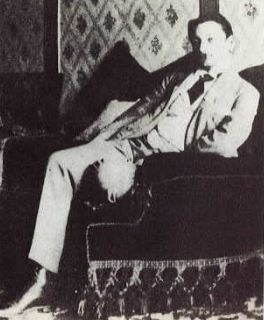Bertrand de Fénelon, friend of Proust
By ADRIAN TAHOURDIN
Among the young men Proust fell in love with was Bertrand de Fénelon (above), who is said to have partly inspired one of the novelist’s most attractive creations, Robert de Saint-Loup (like Fénelon, Saint-Loup was an admirer of Wagner, and bisexual). Born in 1878 – and therefore seven years Proust’s junior – Fénelon was killed in battle a hundred years ago today.
For William Carter, one of Proust’s best biographers (2000), Fénelon was “as handsome as he was distinguished, . . . Slightly aloof, blond, and dapper”. He goes on to say, “His ‘bright blue eyes and flying coat-tails’ reappeared among the elements used to create the marquis de Saint-Loup’s special appeal”. “Like Fénelon, Saint-Loup betrays his class by scorning high society and endorsing leftist policies”.
When Proust sent Fénelon a copy of his early collection of miscellaneous pieces Les Plaisirs et les jours (1896), he inscribed the words “. . . in hopes that he will equal the great literary name he bears” (an ancestor, the Archbishop of Cambrai, had written the Aventures de Télémaque, 1699).
Although Proust’s letters to Fénelon have, according to Carter, “remained in the hands of private collectors”, it’s clear that the novelist became infatuated with him and that the feeling wasn’t entirely reciprocated: “At times the prince enjoyed tormenting Marcel [Carter is not above employing a certain familiarity with his subject], who now suffered from terrible jealousy over Fénelon’s frequent coolness toward him”. At one point the novelist “picked up the new hat Fénelon had bought for his trip to Constantinople [where he was to take up a post at the French embassy], ‘stamped on it, tore it into shreds, and finally ripped out the lining’”.
When war broke out, Proust initially “was unaware that . . . Fénelon, who could have fulfilled his obligation to his country by staying in his diplomatic post, had volunteered for active service”. As Adam Watt reminds us in his excellent short biography of the novelist (2013), he “followed the unfolding of the conflict obsessively", reading “as many as seven newspapers each day”. He was “constantly concerned about being conscripted (despite being quite obviously unfit for service) and about being thought of as a shirker”.
In December 1914, Fénelon was reported missing and, as Carter writes, “a letter from his sister to Proust on 17 February intimated eyewitness corroboration of the rumour” that he had been injured. Confirmation of Fénelon’s death didn’t come until March, published in Le Figaro – it’s amazing how slowly news sometimes travelled from the front. Fénelon had taken a bullet to the head while leading an advance, “a scenario”, says Watt, “with which the death of Robert de Saint-Loup in the novel had much in common”.
Proust wrote to an acquaintance: “You can’t imagine how much intelligence, how much heart, how much heroism there was in that exquisite creature”.
Peter Stothard's Blog
- Peter Stothard's profile
- 30 followers




